July 23, 2013 — Two years after climbing out of the last ship to launch him into orbit, Chris Ferguson was back in a spacecraft on Monday (July 22).
Ferguson, who as commander of NASA's orbiter Atlantis landed the space shuttle program's final mission on July 21, 2011, is retired as an astronaut and is now working at Boeing. There, he is leading development of a commercial space capsule designed to pick up where the shuttle left off.
"Two years and one day... I will tell you, it has gone by so fast," Ferguson says. "But if you can't fly 'em, you might as well build 'em."
On Monday, Ferguson got his first chance to go inside a mockup of the spacecraft he and his team are building, dubbed the CST-100. The gumdrop-shape model capsule is being used by Boeing to fine tune the spacecraft's cabin layout by having NASA astronauts — Ferguson's previous colleagues and crewmates — don pressure suits, strap in and offer their feedback.
"It's an upgrade," says Serena Aunon, taking the capsule for a test fit. "It is an American vehicle, of course it is an upgrade."
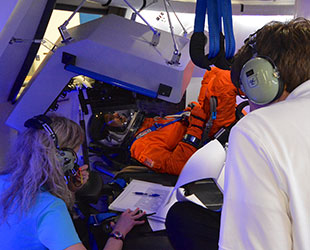
NASA astronaut Randy Bresnik, wearing a shuttle-era Advanced Crew Escape Suit (ACES) pressure suit, takes part in a fit check inside Boeing's CST-100 space capsule mockup. (collectSPACE) |
The CST-100 is one of three private spacecraft being built by U.S. companies to compete for NASA's business flying crew members to and from the space station. The space agency is planning to purchase seats on one or more of the vehicles beginning in 2017.
collectSPACE spoke with Ferguson at Boeing's Houston Product Support Center, before he took his turn touring the inside of the CST-100.
Two years later, is "building 'em" rewarding as "flying 'em"?
I'm proud to be a part of this team. I'm still engaged, still doing things that I really enjoy doing. That is not to say that leaving the shuttle behind wasn't bittersweet. They've done a great job in some of the museums [displaying the retired orbiters]. Some of them are really doing a bang up job, but I prefer to see my rockets vertical and loaded with fuel.
But we can't afford to fly 'em and design 'em at the same time, so we have clearly taken some time off to design the next vehicle. We'll be back within six years, like it was post-Apollo, before shuttle.
I am so pleased that I had the opportunity to be part of the shuttle program, but I am equally thrilled to help [Boeing] build this rocket. I get to make really cool decisions every day. It doesn't get much better than that.
It's been three years since Boeing first announced the CST-100. Is the work here progressing as fast as you say the time since shuttle has gone?
I think we have come dramatically far with a substantially lower budget in a period of time that I would consider to be pretty aggressive.
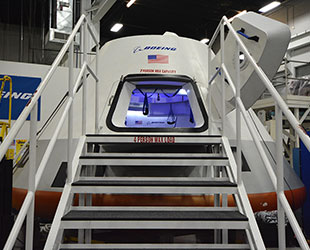
Boeing's CST-100 mockup, which the company revealed on July 22, 2013, seats up to seven crew members. (collectSPACE) |
I know it has been three years, but what you do not see behind this [model capsule's] façade, are the hundreds of engineers who are working to put code behind the displays and who are working on the flight controls who are going to have a vehicle we're going to be able to fly in simulation mode here in four-to-six months.
What is amazing me more than anything about being part of the Boeing team is the depth going into every decision — and I am still amazed on how much left we have to do. We are by no means there, but it's like playing 'whack-a-mole' — when the next problem comes up, we put a team on it, make a decision and move forward. It is just great to work like this.
I haven't worked harder in my life... but I have done things that were a bit more fun.
As you watch your former NASA astronaut colleagues come in for the suited fit checks, do you ever pine to be back in their position?
There is still a little part of me that wishes I was in their shoes. But when I step back and look at it, there is a lot of young engineers who work here. Young MIT, Stanford, Penn, Drexel graduates from these fantastic engineering schools that come in here hungry and they want to learn.
When I think about it, I'm proud of the part that I'm playing in preserving human spaceflight for them. Because they all came here with the same dream that we all had at one point in our life, to go into space. If we don't do this right, or if the country doesn't do this right, they won't have this opportunity.
I've started to grow up a little bit and stop hogging all the fun for myself and I'm trying to make sure we have that capability for these young folks who thrive on this kind of stuff.
Looking at the space shuttles in their museum homes, you get a real sense of how large they were and how small CST-100 is in comparison. Has it been difficult to cram at least the crew capabilities of the orbiter into a capsule?
I never really thought about the cubic feet per person. I'm sure the shuttle rivaled this, probably two to three times over, but thinking about the mission it needs to perform, when the shuttle was designed we didn't have the space station. The shuttle was going to go up and be an orbiting facility for two weeks and you needed the living room in there.
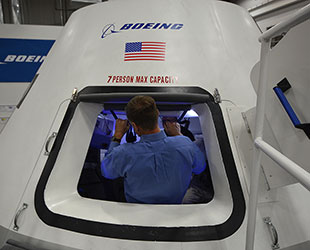
Former shuttle commander and Boeing commercial crew director Chris Ferguson climbs into the CST-100 capsule. (collectSPACE) |
Here, we are going to dock [at the space station] within 24 hours. We're going to dock within 24 hours on a normal mission and six hours after undock, we are going to be on the ground. So it's almost a paradigm shift for those who were brought up on the shuttle mantra of 'Hey, I have to provide for meal time, I have to provide a restroom facility' — which we're going to provide, because you just have to do, but do you have to do it like we did aboard the shuttle? Probably not.
If everything goes well, you're not going to be a passenger in this vehicle in flight for more than 18 hours. We want to dock on flight day one, we have to dock within 24 hours. So this is a lot more Soyuz-like and if you had to compare the internal volume of the Soyuz in cubic feet per person, I think we've got them beat pretty well.
What lessons learned from the shuttle have gone into the design of the controls for CST-100?
The one thing that we learned is that switches and circuit breakers and those kind of things that formed the cockpit of the shuttle, we don't need them. We really don't.
The vehicle is designed to be autonomous. It is going to rendezvous and dock [with ISS] and never have anybody touch anything — on a perfect day. Everything that you see in there gives the pilot the ability to monitor what the autonomy is doing and, in the event that he needs to or she needs to, to take over.
You saw how much rigor was placed into the training of space shuttle astronauts. I mean, it took years. It took a year and a half of 'Astronaut 101' [training], followed by probably another year of mission-specific training. It was a long time.
We will get people ready to fly within nine months, at least that's our goal... and that's simultaneous with their station training.
I think you're going to see something that down scope is largely autonomous with the pilot flying sidesaddle, if you will. We're probably only going to train one, and depending on what NASA wants, maybe two [crew members] to the pilot level of proficiency. You're going to see the training being a lot less imposing than it was during shuttle.
Expanding upon that, on the space shuttle, there was a commander, a pilot and a flight engineer to fly the vehicle. What roles do you need to fly CST-100?
NASA says [CST-100 has] to fly from one to seven [crew members] under the original requirement. They have since changed it to four.
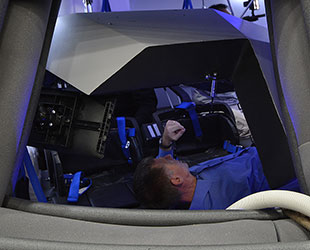
Chris Ferguson inside Boeing's CST-100 mockup. (collectSPACE) |
So, one to four, which implies it has to be single piloted, so we designed it so it can be operated by a single pilot. But when you get in there, you find that the person to the pilot's right, call him by whatever title you want to call him, has access to the entire right of the instrument console, including one of the full displays. So he'll be there to back the pilot up. He can interface with the system if in some case the pilot is not able to.
It is designed to be operated single piloted but it is always nice to have somebody else. And NASA didn't tell us to do that. We did that because it is the right thing to do. You might as well take advantage of your crew and use the resources appropriately. That is what we intend to do.
Right now, you have astronauts in CST-100 wearing space shuttle-era Advanced Crew Escape Suit (ACES) pressure suits, as built by the David Clark Company. Are there reasons you wouldn't or couldn't continue to use the tried-and-true ACES for flight?
If they put a bid in, they could be a contender. But I think ACES has a certain amount of incompatibility with the smaller vehicle. Big helmet, big neck ring, and it's not so much for ascent and entry, but what you do with them in between? It is how to stow them, how to put them away.
With the companies we've been talking to about potential [suit] contenders, we've said 'Think out of the box.' Think in the terms of do you have to have a hard helmet on your head with a big visor on it [or] can I have something that is a little more discreet that is easy to don and doff, and more importantly, is easy to stow. Can I put it in a small, out-of-the-way place, roll it up in a bag and shove it into some compartment where it can sit there and won't take up all my volume.
ACES served the shuttle program well for over a decade and we'd certainly consider it if they decide to put a bid in. But I think the state of the art is, we can evolve.
Speaking of evolving, while CST-100 fits into Boeing's numbering of its airplanes, it doesn't follow the NASA history of naming spacecraft.
We're working on a new name. I have talked with some of the comm folks, and of course [Boeing vice president of space exploration] John Elbon and John Mulholland [vice president and program manager, commercial crew], about the right way to pursue something like this.
Boeing has always refrained from something like this, but then again recently they have kind of lifted that, look at the Dreamliner. So it seems like they are little more willing to be a little more traditional in naming as opposed to just the number system. We'll see what happens.
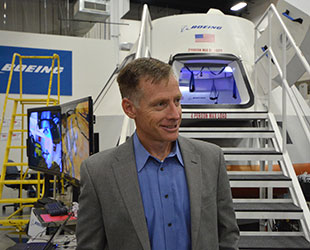
Chris Ferguson stands in front of Boeing's CST-100 model at the company's Houston Product Support Center. (collectSPACE) |
I am pushing for a good name. I'm pushing for something that rolls off your tongue. CST-100 doesn't exactly do that, but it does sound rather technical.
Does CST-100 pilot roll of your tongue? Do you hope to be in the front seat when CST-100 first lifts off?
If they ask me a couple of years down the road, I'll have to think very hard about whether to say yes or no. I'd like to think that someday they will ask me but I think time will tell.
